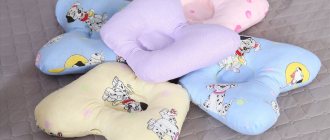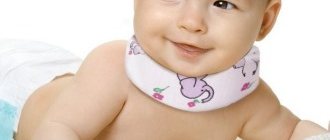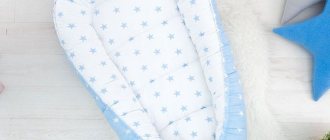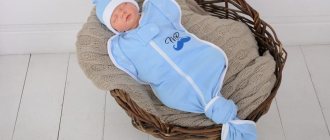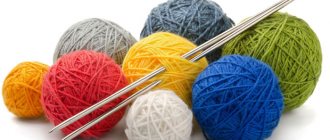At what age does a child need a pillow?
A child sleeps 15-18 hours a day for up to six months, so the load during this period falls on the baby’s head, neck and back.
In the last 5 years, manufacturers have begun to offer special orthopedic products for newborns, namely, pillows, claiming that they help the correct formation of the child’s musculoskeletal system and even protect the baby from aspiration (suffocation). Of course, the new products have become mega-popular. However, let's figure out whether such a pillow is recommended for every baby? And do newborns really need it? The issue causes controversy among pediatricians, orthopedists, parents and grandmothers. Doctors say that it is definitely not necessary for healthy children. Many generations of children grew up healthy without special devices, and modern babies are no different from them. The curves of the spinal column are formed gradually; the child does not need unnecessary tension in the cervical region. But some common diseases of infants require a special approach, for example torticollis. A consultation with a pediatrician and orthopedist will help determine whether or not to buy an orthopedic product to support the child’s head.
How to use an orthopedic pillow
In addition to choosing the right headrest, you need to know how to use it correctly. Failure to follow the manufacturer's recommendations may lead to secondary problems that will further aggravate the situation.
When placing your baby on the pad, always ensure that his head is in the correct position. It should be located strictly in the recess. If the child is lying on his back, there should be a smaller cushion under the neck, and if he is on his side, then the cushion should be higher. Pay attention to how comfortable the baby feels. If it constantly tries to roll over, then the roller is not selected correctly.
What is the difference between a regular pillow and an orthopedic pillow for infants?
- An ordinary children's pillow is made from fillers that are used in the production of adult analogues: down, feathers, wool, synthetic padding. Orthopedic materials are used in hypoallergenic materials with high elasticity and good ventilation.
- An orthopedic pillow for infants has a shape and size that takes into account the characteristics of the child’s body and the structure of the spine.
- The materials of the cover are hypoallergenic and soft to the touch.
- The cover itself is removable and washable.
How to make it yourself
A high-quality orthopedic head pad is not cheap. And those that are sold at a reduced price quickly lose their shape and become unusable. A way out of the situation may be to sew a pillow yourself.
What you need to prepare
Making a butterfly pillow yourself is a little more difficult than a classic bedding product, but it is quite possible. To do this you need to take:
- A large sheet of paper for a pattern.
- Sintepon, which will serve as a filler.
- Cotton, for pillowcase.
- Threads.
- Stationery.
- Needle and pins.
First of all, you should start making the pattern.
Pattern
The pattern is made on a large and fairly thick sheet of paper.
Algorithm:
- Draw a vertical line (length 22.5 cm).
- From the bottom edge of the line, draw a perpendicular line to the right (13.5 cm).
- Do a similar manipulation from the top edge of the line (15 cm).
- Connect the ends of the bases.
- First step back 4 cm from the bottom point of the vertical line, and 6 cm from the top.
- Draw a circle in the center (r-3.5 cm).
- From the first line, step back 1.5 cm at the bottom and top.
- Smoothly connect the resulting points so that the lines resemble the wings of a butterfly.
- Cut out the pattern along the contour lines.
When cutting fabric according to the pattern, you need to add 1-1.5 cm to it on all sides for seams.
Manufacturing
Once the pattern is ready, you can start cutting. To do this, you first need to attach a folded padding polyester to the part, and then cotton, so that their fold coincides with the center of the circle. Next, you need to fold the parts in pairs and sweep them away.
The final stage of manufacturing consists of the following steps:
- Fold the resulting blanks with the right sides of the fabric facing each other and sew them along almost the entire contour.
- While sewing, leave a 4-5 cm section at the top of the product.
- Turn the pillow inside out and iron it gently.
- Fill the wings with padding polyester or latex to make them fuller.
- Sew up the previously left area.
When filling the wings, it is important to remember the unique structure of the orthopedic product. So, the upper part should be noticeably larger than the lower part.
Contraindications for using a pillow for babies
In 70% of cases, an orthopedic pillow causes more harm than good. As mentioned above, its use should be agreed with a doctor. Such a product hinders movement, limiting the mobility of a child’s head during sleep, and this is fraught with negative consequences. There are two main contraindications to the use of orthopedic pillows for newborns:
- The baby is prone to frequent regurgitation
- The baby has problems with the respiratory system
Don’t be fooled by advertising gimmicks; head pillows will not solve the problem of suffocation with vomit.
Popular categories:
- butterfly pillows
- Trelax
- Trives
- with memory effect
- for the head
- for sleep
- for the cervical spine
- to the crib
- inclined
Doctors do not recommend using pillows for newborns and infants. This is due to the fact that in the first year of life the baby actively develops the curvature of the spine. The cervical curve is formed in the first months of a baby’s life, when he learns to hold his head independently. The thoracic curve develops when the baby tries to sit, and the lumbar spine develops at the age when the child takes his first steps. But there are cases when a children's orthopedic pillow for newborns is recommended by a doctor. Then you should carefully choose the product.
Types of orthopedic pillows
The wide range of modern pillows makes it difficult for parents to choose. To systematize the information, we will describe the existing models of pillows for newborns.
- The most common is the orthopedic butterfly pillow . This is a small roller with a recessed part in the center. It fixes the baby's head, helping the correct formation of the skull and cervical curve. You can use a butterfly pillow from the 2nd month on the recommendation of a specialist.
- A positioner pillow – although it is called a “pillow”, it is not one. This is a flat product with 2 bolsters on the sides, which allow you to fix the baby’s body in a “sideways” position. The model is recommended for children with a tendency to regurgitate. It will be useful in the first 3-4 months of a child’s life.
- The third type is an inclined pillow . It is made wide, of small height and with a slope of 15 degrees. The product is used to support the baby’s torso in an elevated position; compliance with the width of the crib is its main criterion.
- The next model is called a ring pillow , but it is not placed under the head. It is used during breastfeeding and is a good helper for the mother. Having settled the baby in the pillow, she frees her hands and can take a comfortable position.
Why do you need an orthopedic pillow for newborns?
First of all, such a product is necessary for the formation and proper development of the spine. When lying straight on your back, there is a high load on the spine, so there is a high risk of cramps. A comfortable pad under the head will help you choose the right posture while resting, and will also allow your baby to quickly master the skills of sitting and walking, all thanks to the fact that from the first days of his life he will experience sufficient physical activity.
You cannot do without a children's orthopedic pillow if you have postural defects and abnormalities in the development of the muscular system. In this situation, the product will help correct the problem and prevent its further deterioration.
A correctly chosen cushion under your head will help:
- normalization of weight and height;
- formation of bone tissue from cartilage;
- improving posture;
- support and development of the cervical spine.
The main indications for using this product include:
- increased tone of the neck muscles;
- torticollis;
- head and cervical injuries received in the womb;
- irregular head shape;
- rickets is not in the early stages;
- skeletal abnormalities.
This accessory is able to adapt to the physiological characteristics of the baby and have a positive effect on his health. If you have congenital pathologies, you cannot do without such a product.
Features of care
The issue of using pillows for a crib cannot be considered settled unless you learn how to care for such products. So:
- Orthopedic pillows made from natural plant materials - buckwheat, coconut coir, etc. cannot be washed.
- Latex, memory, bamboo fiber can be washed by hand or in a machine on a delicate cycle, at a water temperature not exceeding 40 C.
- When washing, use non-aggressive and hypoallergenic products.
- The spin mode is minimal; the pillow cannot be twisted.
- Such a product should be dried horizontally, in the shade.
Orthopedic pillow fillers
Very diverse and maximally functional.
Buckwheat husk
– creates a light massage effect during sleep, providing the perfect balance of firmness and comfort.
The most natural, environmentally friendly and relatively inexpensive filler. However, such a pillow “rustles” when used and you will have to change it every 2-3 years. Latex
- provides elasticity and holds its shape well.
Natural filler that does not retain moisture, is durable and hygienic. The surface of latex pillows can also have a massage effect due to tubercles and ribbing. They may have a specific smell when purchased, but the smell dissipates over time. Viscoelastic MemoryFoam
is a specially created filler with the so-called memory effect, which allows you to slowly “sink” into the pillow, anatomically completely following the shape of the body.
In the same way, the pillow is able to return to its original form. This material is softer than others. So, if you need a pillow with a therapeutic effect if you have health problems, it is recommended to pay attention to other fillers. Polyurethane foam
is the most common filler, which has a greater orthopedic effect. One of the disadvantages of this material can be mentioned - insufficient breathability. So, the pillow can heat up from body temperature.
Natural fillers in the form of down or feathers are a favorable environment for the growth of bacteria and dust mites. They can cause allergies, ailments, and reduce local immunity.
- The height of the bolster (if any) or the height of the edge of the pillow should correspond to the length of the shoulder (the distance from the edge of the shoulder to the neck is measured in centimeters). A high pillow is for broad shoulders.
- Before you buy an orthopedic pillow, you need to “try it on” while lying down. 10 minutes will be enough to understand whether this is your pillow or whether you should choose another one. The pillow should fill the neck space.
- Pay attention to the hardness of the pillow; it should be exactly what will be comfortable for you. At the same time, such a pillow should not lose its shape.
- If you like to sleep on your stomach, give preference to soft and low pillows, as well as pillows with notches in the middle, butterflies.
- If you are using a soft mattress, choose a low pillow. For hard mattresses – higher, so as not to create an imbalance.
- An orthopedic pillow registered with Roszdravnadzor as an orthopedic product is the key to its quality and effective functions.
Switching from a simple pillow to an orthopedic pillow is a process. And you will have to get used to the new pillow, because at this moment you may experience slight discomfort. But when your body readjusts to sleep correctly, you will notice improvements in both the quality of your sleep and your well-being. All this is achieved due to the fact that the “correct pillow” ensures good blood flow, does not overextend the muscles and ensures a natural position of the body during sleep. Be healthy!
